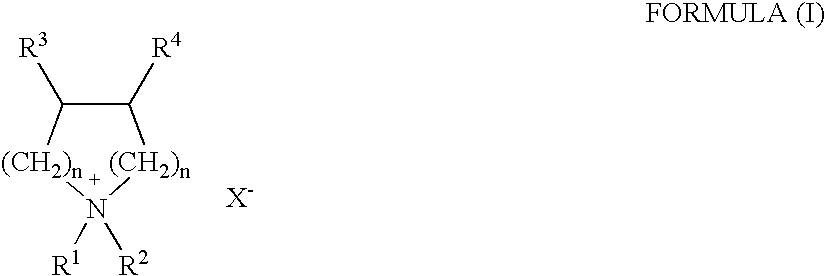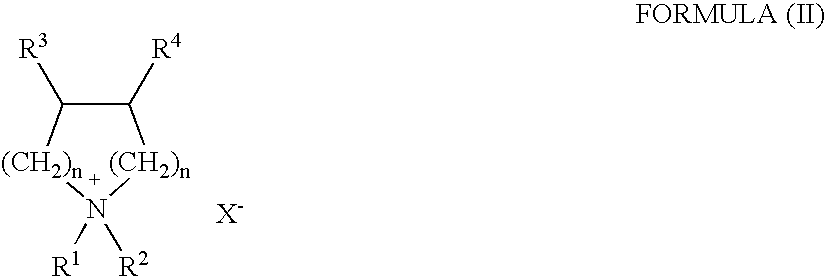Cationic amphiphiles for intracellular delivery of therapeutic molecules and its composition, process and method of treatment
- Summary
- Abstract
- Description
- Claims
- Application Information
AI Technical Summary
Benefits of technology
Problems solved by technology
Method used
Image
Examples
example 1
[0152] Synthesis of N,N-di-n-dodecyl-3,4-dihydroxy pyrrolidinium chloride (amphiphile 1)
[0153] Step (a). To 5 g n-dodecyl amine (27 mmol) dissolved in 10 ml DMSO, 6.7 g of n-dodecyl bromide (27 mmol),and 3.7 g of potassium carbonate (27 mmol) were added. The mixture was kept under stirring for 24 hours at 80.degree. C. The reaction mixture was taken in chloroform 100 ml and washed with water (2.times.150 ml), the chloroform layer was dried over anhydrous sodium sulfate and filtered. Chloroform was removed from the filtrate on a rotary evaporator and column chromatographic purification (using 60-120 mesh size silica) of the residue using 1-2% methanol in chloroform as an eluent afforded (3.4 g, yield 35%) of the desired intermediate secondary amine, namely, N,N-di-n-dodecylamine.
[0154] Step (b). To erythritol (4 g 33.9 mmol) dissolved in 100 ml dry pyridine, tosyl chloride (11.6 g, 61 mmol), a few crystals of DMAP were added. The mixture was kept under stirring for 1 h at -5.degree. ...
example 2
[0157] Procedure for the Preparation of N,N-di-n-tetradecyl-3,4-dihydroxy pyrrolidinium chloride (Amphiphile No. 2).
[0158] Step (a). To 5 g n-tetradecyl amine (23.4 mmol) dissolved in 10 ml DMSO, 6.4 g of n-tetradecyl bromide (23.4 mmol),and 3.2 g of potassium carbonate (23.4 mmol) were added. The mixture was kept under stirring for 24 hours at 80.degree. C. The reaction mixture was taken in 100 ml chloroform and washed with water (2.times.150 ml), the chloroform layer was dried over anhydrous sodium sulfate and filtered. Chloroform was removed from the filtrate on a rotary evaporator and column chromatographic purification (using 60-120 mesh size silica) of the residue using 1-2% methanol in chloroform as the eluent afforded 3.4 g (35% yield) of the desired intermediate secondary amine, namely, N,N-di-n-tetradecylamine.
[0159] Step (b). To 4 g of erythritol (33.9 mmol) dissolved in 100 ml dry pyridine, tosyl chloride 11.6 g, (61 mmol), a few crystals of DMAP were added. The mixture ...
example 3
[0162] Procedure for the Preparation of N,N-di-n-hexadecyl-3,4-dihydroxy pyrrolidinium chloride (Amphiphile No. 3).
[0163] Step (a). To 5 g n-hexadecyl amine (20.7 mmol) dissolved in 10 ml DMSO, 6.3 g of n-hexadecyl bromide (20.7 mmol),and 2.9 g of potassium carbonate (20.7 mmol) were added. The mixture was kept under stirring for 24 hours at 80.degree. C. The reaction mixture was taken in 100 ml chloroform and washed with water (2.times.150 ml), the chloroform layer was dried over anhydrous sodium sulfate and filtered. Chloroform was removed from the filtrate on a rotary evaporator and column chromatographic purification (using 60-120 mesh size silica) of the residue using 1-2% methanol in chloroform as the eluent afforded 3.4 g (35% yield) of the desired intermediate secondary amine, namely, N,N-di-n-hexadecylamine.
[0164] Step (b). To 4 g of erythritol (33.9 mmol) dissolved in 100 ml dry pyridine, tosyl chloride 11.6 g, (61 mmol), a few crystals of DMAP were added. The mixture was ...
PUM
| Property | Measurement | Unit |
|---|---|---|
| Fraction | aaaaa | aaaaa |
| Angle | aaaaa | aaaaa |
| Angle | aaaaa | aaaaa |
Abstract
Description
Claims
Application Information
 Login to View More
Login to View More - R&D Engineer
- R&D Manager
- IP Professional
- Industry Leading Data Capabilities
- Powerful AI technology
- Patent DNA Extraction
Browse by: Latest US Patents, China's latest patents, Technical Efficacy Thesaurus, Application Domain, Technology Topic, Popular Technical Reports.
© 2024 PatSnap. All rights reserved.Legal|Privacy policy|Modern Slavery Act Transparency Statement|Sitemap|About US| Contact US: help@patsnap.com










